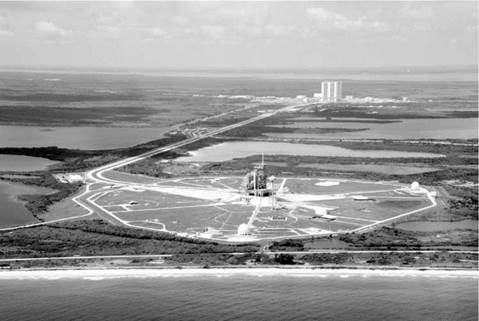PHASES OF A SPACE FLIGHT
In all space flights, there are three phases that are common to each mission. Though the profile, objectives, and even the hardware changes, the sequence remains the same for human missions—launch, inflight, and landing.
Launch sites
There have only been three launch sites used to send humans into orbit since 1961, one each in the Soviet Union, the United States, and China. In addition, Edwards
|
Launch Complex 39, Kennedy Space Center, Florida, U. S.A. |
Air Force Base in California was the home of the X-15 program from which a series of “astro-flights” were conducted in the 1960s. Nearby Mojave Airport was the departure point for the 2004 SpaceShipOne flights. Despite plans, there were no launches of military Manned Orbiting Laboratory missions in the 1960s, nor classified Shuttle missions during the 1980s, from the Vandenberg Air Force Base Space Launch Complex 6 (SLC-6, also known as “Slick-6”) in California.
The first launch of a manned orbital space flight, on April 12, 1961, was from Pad 1 at Site 5 at the huge Baikonur Cosmodrome, in what was Soviet Central Asia (now known as the Republic of Kazakhstan). All subsequent Soviet/Russian manned launches have taken place from the same cosmodrome, though a few have used Pad 31 at Site 6.
Similarly, all American manned space flights have begun from the extensive launch complex at Cape Canaveral in Florida. The early missions launched from Pad 5 (used for the suborbital Mercury-Redstone launches), 14 (Mercury Atlas), 19 (Gemini Titan), or 34 (Apollo Saturn IB), with the Pad A or В sites at Launch Complex 39 serving as the launch site for all Apollo Saturn V and Skylab/ASTP Saturn IB missions. The LC-39 pads were subsequently converted to launch all 135 Shuttle missions. As changes take place once more in Florida to remove Shuttle-related launch systems and install facilities for the next generation of U. S. launch vehicles, these historic pads will be used to place new American vehicles into orbit. Across the world in China, the third launch site for manned spacecraft is located in Jiuquan and is used to support the launch of Shenzhou missions.











